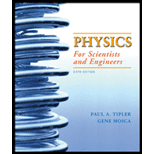
Concept explainers
(a)
The distance travelled by the particle during the time
(a)
Explanation of Solution
Given:
The time period of the particle is
The amplitude of the oscillation of the particle is
Formula used:
The position of the particle is given as:
Here,
Write the expression for the angular frequency of oscillation.
Substitute
Write the expression for the initial position of the particle with amplitude and phase constant.
Simplify the above equation we get.
Substitute
Substitute
Now the distance particle travels in initial time
Calculation:
Substitute
Conclusion:
The distance the particle travels at
(b)
The distance travelled by the particle at time
(b)
Explanation of Solution
Given:
The time period of the particle is
The amplitude of the oscillation of the particle is
Formula used:
The position of the particle is given as:
Here,
Calculation:
Substitute
Conclusion:
The position of the particle is
(c)
The distance travelled by the particle
(c)
Explanation of Solution
Given:
The time period of the particle is
The amplitude of the oscillation of the particle is
Formula used:
The position of the particle is given as:
Calculation:
Substitute
Conclusion:
The position of the particle is
(d)
The distance travelled by the particle
(d)
Explanation of Solution
Given:
The time period of the particle is
The amplitude of the oscillation of the particle is
Formula used:
The position of the particle is given as:
Calculation:
Substitute
Conclusion:
The position of the particle is
Want to see more full solutions like this?
Chapter 14 Solutions
EBK PHYSICS FOR SCIENTISTS AND ENGINEER
- Can someone help me with this question. Thanks.arrow_forwardIdentical rays of light enter three transparent blocks composed of different materials. Light slows down upon entering the blocks.arrow_forwardFor single-slit diffraction, calculate the first three values of (the total phase difference between rays from each edge of the slit) that produce subsidiary maxima by a) using the phasor model, b) setting dr = 0, where I is given by, I = Io (sin (10) ². 2arrow_forward
 Physics for Scientists and Engineers: Foundations...PhysicsISBN:9781133939146Author:Katz, Debora M.Publisher:Cengage Learning
Physics for Scientists and Engineers: Foundations...PhysicsISBN:9781133939146Author:Katz, Debora M.Publisher:Cengage Learning Principles of Physics: A Calculus-Based TextPhysicsISBN:9781133104261Author:Raymond A. Serway, John W. JewettPublisher:Cengage Learning
Principles of Physics: A Calculus-Based TextPhysicsISBN:9781133104261Author:Raymond A. Serway, John W. JewettPublisher:Cengage Learning Classical Dynamics of Particles and SystemsPhysicsISBN:9780534408961Author:Stephen T. Thornton, Jerry B. MarionPublisher:Cengage Learning
Classical Dynamics of Particles and SystemsPhysicsISBN:9780534408961Author:Stephen T. Thornton, Jerry B. MarionPublisher:Cengage Learning University Physics Volume 1PhysicsISBN:9781938168277Author:William Moebs, Samuel J. Ling, Jeff SannyPublisher:OpenStax - Rice University
University Physics Volume 1PhysicsISBN:9781938168277Author:William Moebs, Samuel J. Ling, Jeff SannyPublisher:OpenStax - Rice University Modern PhysicsPhysicsISBN:9781111794378Author:Raymond A. Serway, Clement J. Moses, Curt A. MoyerPublisher:Cengage Learning
Modern PhysicsPhysicsISBN:9781111794378Author:Raymond A. Serway, Clement J. Moses, Curt A. MoyerPublisher:Cengage Learning Physics for Scientists and EngineersPhysicsISBN:9781337553278Author:Raymond A. Serway, John W. JewettPublisher:Cengage Learning
Physics for Scientists and EngineersPhysicsISBN:9781337553278Author:Raymond A. Serway, John W. JewettPublisher:Cengage Learning





